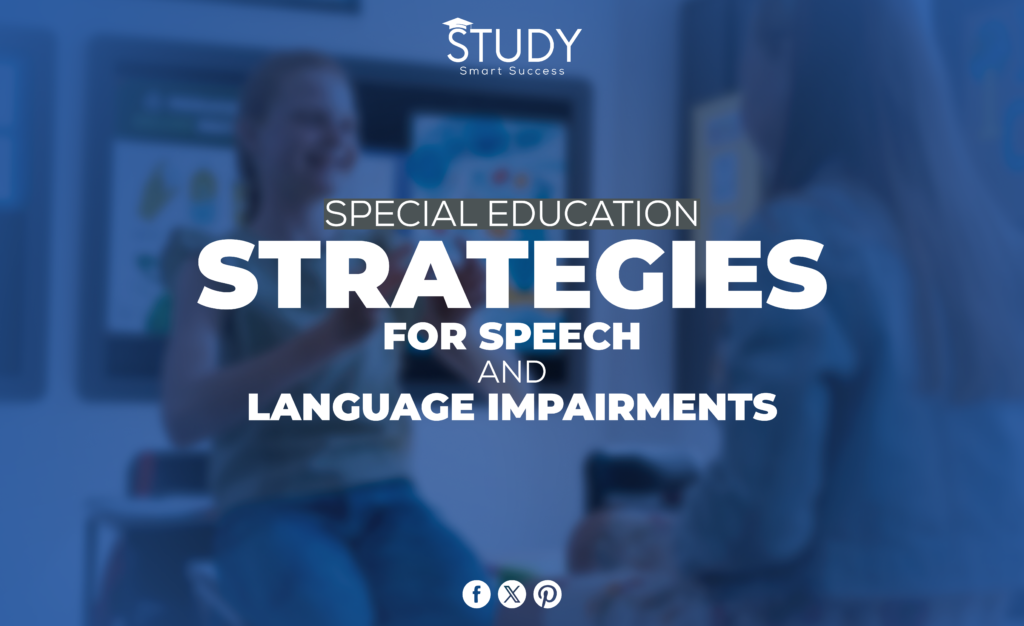Introduction
Speech and Language Impairments (SLI) include many problems that make it hard to understand what others say or express one’s thoughts. These could range from stuttering or trouble pronouncing words to difficulty understanding and using language.
Special education must deal with SLI because these disabilities can hurt a student’s schoolwork, relationships, and general quality of life. Early and effective intervention can lessen these effects, essential to better educational results and social integration.
This post aims to shed light on successful ways to help students with Speech and Language Impairments. We want to give teachers, speech-language pathologists, and parents the tools to help kids deal with these problems and do well in school by looking at real-world solutions.
Learn more about Intellectual Disabilities.
Understanding Speech and Language Impairments
Definition and characteristics of SLI
People with speech and language impairments (SLI) show their signs differently. These problems make speaking, understanding, and using language appropriately tricky. People with speech and language impairments (SLI) display different signs.
Key Characteristics of SLI
Delayed Speech Development—Children with SLI may reach specific speech stages much later than their peers. This can show up as a small vocabulary, talking later than usual, and trouble making acceptable sentences for their age.
Articulation Disorders – Some people may need help making correct sounds. This can include leaving out, replacing, or altering sounds, which makes it hard to understand what they’re saying.
Fluency Disorders include problems like stuttering and cluttering, in which sounds, syllables, words, or sentences repeat or get more extended than they should without the person’s meaning.
Language Comprehension Challenges – They may have difficulty understanding spoken language, following directions, or processing what they hear, making it hard to react correctly.
Pragmatic Language Difficulties – This is about problems with social communication, like needing to be able to use language for different reasons (like greeting, informing, or asking), adapting language to the person or situation, and following rules for conversations and stories.
Different types of SLI
Here are some specifics about the different kinds of Speech and Language Impairments (SLI):
Expressive Language Disorder – This type focuses on people who have trouble expressing themselves, meaning they have difficulty putting their thoughts into words or lines, making it hard for them to talk to others.
Receptive Language Disorder significantly affects your ability to understand and process other people’s words. For some people, this can make it hard to follow directions, know what they hear, and have talks.
Mixed Receptive-Expressive Language Disorder – Having both of the above disorders at the same time, this one affects both learning and using language. People with this disorder have a lot of trouble with receiving and expressing words.
Phonological Disorder – This is a specific articulation disease where it is hard to understand and follow the rules for making sounds and sound patterns in a language. This makes speech hard to understand.
Stuttering (Fluency Disorder) – Disruptions in the flow of speech, such as repeated sounds, syllables, or words, making sounds last longer, or pausing without meaning.
Impact of SLI on academic, social, and emotional development
Speech and Language Impairments (SLI) can have a significant effect on a child’s social, emotional, and intellectual growth in many ways:
Academic Challenges – Children with SLI often struggle to understand what they read, write clearly, and participate in class discussions. This can cause students to do worse in school and make them more likely to quit.
Social Difficulties – Being unable to communicate well can make it harder to make friends and be social, making you feel alone and limiting your chances to play and connect with others.
Emotional and Behavioral Issues – Students with SLI are more likely to have mental health issues like depression and worry. They may also have behavior issues because they are angry or feel excluded from social groups.
Self-Esteem – A child’s self-esteem and confidence can drop when they have trouble communicating. They might feel like they’re not like their friends and can’t explain themselves well.
Impact on the Family—Families may also feel the effects of SLI as they try to figure out the school system, advocate for their child, and find the right help and solutions.
Speech-Language Therapy Interventions
Articulation Therapy
Articulation treatment is one of the main ways to fix speech sound problems directly. Here are four essential things to know about this method of therapy:
Individualized Treatment Plans – The person’s therapy is geared to the sounds or patterns of sounds they have trouble with. These plans are made for each student, considering their specific needs and skills.
Systematic Approach – The therapy works planned, moving from more accessible sounds to harder ones. In this way, the student’s ability to make the right sounds gradually improves.
Incorporation of Visual and Auditory Feedback – Students can often understand and improve their speech in real-time with the help of tools and technologies that give them visual and audio feedback.
Parent and Caregiver Involvement—It is essential to include parents and other providers in therapy. They are taught how to do exercises and follow methods at home, which helps with consistency and speeds up progress.
Language Therapy
Expanding Vocabulary – Language therapy combines classification, naming, and context-based word exposure to broaden a child’s vocabulary. They can express themselves better by increasing their linguistic base.
Enhancing Comprehension Skills – Therapists educate students to derive meaning from context, detect crucial details, and follow complex directions to increase language understanding. Academic progress and daily communication require these skills.
Social Communication Techniques – Due to pragmatic language issues, SLI therapy teaches social cues, turn-taking, subject maintenance, and non-literal language interpretation to improve social interaction.
Narrative Skills Development – Storytelling activities, including recognizing story structure, arranging events, and developing their own stories, help build expressive and receptive language. This is essential for written communication and academic assignments.
Augmentative and Alternative Communication (AAC)
Use of Technology and Devices—AAC includes simple graphic boards and elaborate electronic speech generators that enhance or replace natural speech for people with severe communication impairments.
Customization and Adaptability – It is easy to change these tools to fit each person’s needs, preferences, and skills, and those needs can be changed over time.
Training and Support – For AAC to work well, the person who uses it needs special training, as well as family members, teachers, and friends who need to know how to talk to the person who uses an AAC device.
Enhancing Independence – AAC devices give people more power by letting them say what they want, share their thoughts and feelings, and connect with others. This makes them more independent and improves their quality of life.
Classroom Accommodations and Modifications
Providing Visual Supports
- Using visual schedules, graphic organizers, and cue cards to help students understand language better and follow classroom rules and complex directions.
- During lessons, using pictures, diagrams, and videos to make abstract ideas more accurate and easy to understand can help students understand and remember what they are learning.
- Students with SLI should have enough time to understand and participate in classroom activities and discussions, and the pace of teaching should be adjusted to fit their language processing speed.
- Making the classroom a safe place where people can participate without worrying about being judged will help them feel like they fit in and significantly reduce their anxiety regarding communication tasks.
Adjusting Communication Expectations
- Giving students more time to think about their answers will help them feel less stressed and anxious when talking on the spot.
- By encouraging students to help each other and work together on communication tasks, teachers can create a safe space where students can practice their language skills without worrying about being judged.
- To ensure fair assessment of knowledge and skills, offer oral presentations instead of written reports or allow extra time for tests.
- Signs, gestures, and AAC devices can help students comprehend and express themselves in the classroom, making learning more inclusive and prosperous.
Incorporating Multisensory Learning
- Hands-on activities, movement, and sensory experiences keep students interested, and different learning styles are considered. This helps students remember language ideas.
- Using educational applications and online platforms with interactive exercises and simulations to reinforce linguistic principles makes learning fun and effective.
- Storytelling and role-playing help students practice language skills in many circumstances and improve their narrative competency.
- Music and rhythm can increase memory and recall, help SLI students acquire language patterns and structures, and make learning fun.
Creating a Supportive Learning Environment
Educating Peers and Teachers
- Promoting awareness and understanding of SLI among peers and educators helps create a more supportive and empathetic learning environment. Educational workshops on SLI students’ challenges and needs develop empathy and collaboration.
- Teacher training and resources are crucial for supporting students with SLI. Tailored instruction and assistive technologies can meet these children’s unique requirements, and professional development may teach teachers how to create inclusive classrooms.
Fostering Peer Interaction
- SLI kids need peer contacts and friendships to develop communication and social skills. In a natural and supportive context, structured social activities and supervised play can assist these students in improving communication.
- Inclusion and support programs through peer mentoring help SLI students create leadership and empathy in their peers. These programs can match SLI students with more proficient peers for mutual benefit, fostering social and language growth and a sense of belonging.
Challenges and Future Directions
Persistent Challenges in Supporting Students with SLI in Educational Settings
- Limited Awareness and Misdiagnosis – Due to a lack of awareness among educators, parents, and healthcare providers, SLI is still underdiagnosed or misdiagnosed. This delays interventions and assistance, harming a child’s intellectual and social development.
- Access to Resources—Speech-language therapists and assistive technology are not available at all locations or schools. Due to this imbalance, SLI students may receive unequal support and outcomes.
- Integration of Effective Teaching Strategies – Effective educational strategies for SLI kids exist, but executing them consistently in classrooms takes time and effort. Many teachers need more training and resources to teach these students adequately.
- Social and Emotional Barriers – Social and emotional issues like peer relationships, self-esteem, anxiety, and depression are common in SLI students. Creating a friendly and inclusive educational atmosphere that tackles these concerns is crucial yet difficult.
Future Directions for Enhancing Support for Students with SLI
- Innovative Technology Integration – Adopting cutting-edge technologies like AR and VR in therapeutic and educational settings could improve engagement and personalized learning for SLI students.
- Interdisciplinary Collaboration – Encourage educators, speech-language therapists, psychologists, and parents to work together to build a holistic support structure that addresses SLI students’ diverse needs for more thorough and successful intervention options.
- Policy and Advocacy – Strengthening advocacy to influence school policy and obtain more funding for SLI-specific research, resources, and training would help these students flourish academically and socially.
- Longitudinal Research – Longitudinal studies of SLI students can reveal the efficacy of diverse interventions and support techniques, directing education and therapeutic approaches.
Conclusion
Specialist education practices are crucial for speech and language impairments (SLI) students. This publication has examined a variety of adjustments, adaptations, and supportive methods, emphasizing the need for a customized education that addresses these children’s unique issues. Communicating well is vital to learning, and these tactics help improve SLI students’ academic and social results.
Educators, policymakers, and communities must work together to protect SLI students’ educational rights. Raising funds, hiring experienced experts, and integrating extensive support systems into schools are vital to improving education equity. Promoting SLI awareness among the public and professionals can help these students succeed by triggering a cultural transformation.
Inclusion is a continuous process that recognizes and meets the different needs of all students. Addressing SLI problems improves student learning and upholds equity and accessibility in education. By adapting, innovating, and advocating, we can allow every student to flourish without communication barriers.


